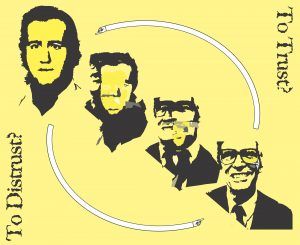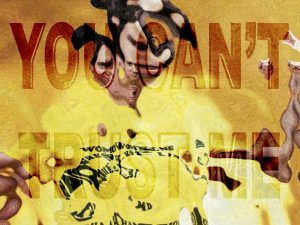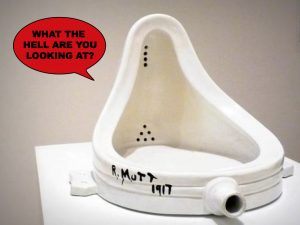by Nickolas Calabrese

Recently the person whom I had been in a serious cohabiting relationship with for the past few years disappeared. Not in the Unsolved Mysteries kind of way, but in the “I just ghosted you because I can’t deal with breaking up with you in person” kind of way. She was spending a month working at an artisan’s residency in Seattle, when, one week in, she suddenly stopped responding to any correspondence. After a few weeks I finally spoke on the phone with R and she said that she simply had a change of heart and was now going to be living with her sister, shortly afterward arranging to have her belongings packed and moved by professionals. I didn’t see this coming – R never let on that anything was amiss, going so far as to mailing me a letter during that first week at the residency declaring her love and desire for marriage, kids, the whole nine yards. We rarely had arguments, everything was good. She had simply changed her mind. I was surprised.
Now I’m sure this sort of thing happens all the time. And it’s reasonable that she wanted something else out of life, something that I could not offer. But allow me to ruminate on this surprise for a moment. I was surprised because I had assigned my highest subjective commitment of trust to her, beyond anybody else. After all, you place trust in someone that you deem trustworthy. Trustworthiness is not an inherent quality to any given person, it is an evaluation that you yourself make about the apparent reasons for why you ought to trust another. But it is not without risk: whenever you choose to trust someone you take a gamble on whether or not your trust will be broken, which can result in being hurt emotionally or otherwise.
Trusting someone entails personal risk, whether it’s a politician, a salesperson, a loved one, etc. When we trust someone, we commit ourselves to them, forming a unique bond that implies a higher level of interpersonal relationship. Most versions of the social contract are based in trust (John Rawls’ lies a little outside, as his ideal of justice is determined from behind a veil of ignorance, reducing the need for person to person trust).
We don’t have to worry about our faith in other people all the time; only when it is put to the test. We have the social contract to thank for not needing to constantly play the sceptic. For instance, when your babysitter says she’ll show up to babysit for you, you can have confidence that she will. When your significant other says they love you, you ought to believe it’s true without question each time barring any suspicious activity. The same holds for when you are driving down the freeway – you rely upon the assumption that oncoming traffic won’t suddenly veer into your lane. We trust each other implicitly on a daily basis. So what happens when these mechanisms of trust break down. Once trust is broken, what is the next step? This is where a lot of literature on the topic trails off, because trust either works or it doesn’t. The burden of trust is that if it fails you in general cases, it is pretty much your fault. You should have been keener to the conditions that you based trustworthiness on. If somebody burns you by not showing up for you, that’s not a crime, it’s a bad judgment on your part. Of course there are cases where it is a crime, like if a doctor operates upon you while intoxicated – that violation of trust is punishable in court. But in most regular cases of trusting other people, the hazard of emotional harm is your risk. In short, trust is a required part of living in a society. Without it we are intensely guarded, recklessly paranoid, vulnerable to all sorts of malevolence. None of this is very controversial.
But I’m an artist, and what I want to understand is what the role of trust is within the realm of art. Because it seems to me to operate rather differently there than it does in everyday life. Andy Kaufman performed his original song “I Trusted You” in 1977 on the music program Midnight Special. Kaufman’s work was predicated on the misplaced trust of his audience. We were never supposed to know what the real angle was for one of his performances. When he wrestled women, for instance, were we supposed to think he’s some megalomaniac or a dweeb playing the part of frustrated machismo? Is an artwork meant to convey the truth, or is the work itself meant to convey something outside the very concept truth? Kaufman was turning the phrase most often lobbed at him by fans and critics (about whether or not to trust his antics as real) and spitting it right back out at them. What the audience did was trust in him to breach their trust, which is a contradiction, right? He was defying real world expectations for which we have built evaluative faculties. You shouldn’t trust Andy Kaufman. But you shouldn’t distrust him either. You should, rather, suspend trust as a concept in particular when experiencing his performances. This is not unlike the Kantian method of suspending judgment during the experience of sublime beauty.

When Marcel Duchamp showed his painting Nude Descending a Staircase, No. 2 at the Armory show in 1913, people were shocked. When he put a urinal titled Fountain on a pedestal in 1917, they were outraged. Nowadays many folks still don’t know what to think about the works he produced because he either said very little about them or spoke cryptically. You will still invariably overhear an uninitiated museum-goer declare “bullshit” on Duchamp’s ready-mades. It might be the case that art is incapable of telling the truth. Or a lie for that matter. If art does not operate as a language, and does not speak (despite the insistence of several notable champions of the theory, like Nelson Goodman), then it must operate as phenomena. Artworks have no truth to tell, because they are artificial. What an artist said and what art historians say about their works are often two completely different things. But artworks themselves are mute. They are, strictly speaking, spoken about, but not speaking at all, which is not to say that there are not operational symbols within the works (all language is symbolic but not all symbols are linguistic).
Paul Valery suggested that art provokes a muted response during his opening address at the Second International Congress on Aesthetics and the Science of Art in Paris, 1937. There he says (about the effect of beauty and about aesthetic affect in general) that “the effect of the Beautiful upon a man is to make him mute. Mute, at first; but we shall soon observe another effect that is somewhat remarkable: if, without the least intention of judging, we try to describe our immediate impressions of what has just taken place in our sensibility, we shall find that we cannot avoid contradiction.” This is a jump from the work itself to the aesthetic response, but they are related. The contradiction that he refers to, I believe, is that aesthetic concepts like beautiful or ugly do not speak, they just are, and therefore we have nothing to believe in or not believe in. The experience of an artwork is just that: experience. An emotional experience sure. If when standing at the base of a waterfall one was to say “that’s bullshit”, they would at best be using language incorrectly. In general people do not question the veracity of beauty, nor the veracity of pain, unless it appears as propaganda in media, or an aberration in their perception, such as being under the influence of psychedelic drugs.
Valery was writing romantically about something that has been challenged in recent years. With the rising tide of a more politically self-aware left, artworks are now being questioned beyond the intention of the artists. One such instance was Dana Schutz’s painting Open Casket at the last Whitney Biennial, which depicted Emmett Till in his casket. This work was derided as using black pain as material. The charge was that she cannot truly empathize with black pain as a white person. In an open letter to the artist, it was suggested that the work should be destroyed, not because the subject matter was not worth painting, but because it wasn’t her truth to tell. In the case of Schutz, the veracity of her content was questioned. This is a reasonable question to pose as she seems to have made a potentially disrespectful move. One upshot of this position is that it puts the artist in a spot that some argue they ought not to be in. I’m talking about the old debate of whether or not one should take into account the artists themselves or let the works stand alone (remember Duchamp’s Fountain, which he never spoke about in any direct manner, has been interpreted by critics like Calvin Tomkins as being reminiscent of Renaissance painting and by others as being toilet humor (literally!)). The painting of the open casket, without considering the artist’s intention, stands alone as a successful and powerful image, and only begins to fail when we consider who the artist is.
Now this should not be misconstrued as an argument that artist’s intention should not have anything to do with the artwork in its final form. I am speaking, rather, to the primacy of the work itself, and the fact that it has more presence and more formal distinction as a thing than the creator’s intentions do. You can see the artwork. You cannot see intention. After all, when you are constructing a symbolic object out of non-linguistic materials, there’s no reason to expect that anybody would be on exactly the same page. Artist’s intention is important, but what an artwork is is more important. There are exceptions to all of this, but we are generalizing here.

An alternative view of artworks could be that they are feelings or emotions. In general emotions are neither true nor false (feelings can be illusions, but it seems that if a feeling was “false” it would actually be the underlying facts that are false (like “I loved you but it was a lie”; the reasons for trusting that person would be false, but not love itself – that love was a real feeling)). They are not neutral, but they do not adhere to the conditions of truths and falsehoods. They can be offensive! In the case of Schutz, it was the artist herself who was offensive, not the painting. Artworks have a life of their own. The artist might be an asshole, or really inappropriately tone-deaf, but once the artworks have been produced, they exist on their own terms. The swastika has gone through several transformations in meaning, owing nothing to whoever designed it in the first place, ranging from symbol of peace to symbol of genocide. Wagner’s “Bridal Chorus” from Lohengrin – a song played at the union of Elsa and the knight Lohengrin – reflected a marriage that was ill-fated for tragedy and was written by an anti-Semite. But now the wedding song reflects one of the happiest days of many people’s lives.
Of course it could be argued that if the premises of an artwork (the reasons an artist has for producing the artwork) are false, then the artwork itself would be false. It might be more appropriate to say that although the reasons that underline an artwork may be true or false, the thing itself is inapplicable to the language of truth because of how relative it can be. When somebody is scammed by a con artist, they feel real empathy towards that person, even though the premise is false. You would never say that that wasn’t actually empathy, just that you were fooled into feeling that empathy. Art has a tricky way of enveloping or repelling us, regardless of what an artist might mean by it. It is the job of real fans of art to dig deeper and play the historian, divining each detail provided by the artist and their biography. And while that should have some impact on the final read, it is far from the whole story.
When R disappeared, the pain and confusion I felt from having my trust broken was significant. I knew that somewhere along the line I had made a considerable error in judgment. My trust had real relations to the world, to facts, to truth, and barring her being a sociopath, I should have had a sharper sense about what was going on. The reason artworks provide people with pleasure, the reason why Beethoven’s 9th is so moving, is that it provides escape from our lives into a much more intimate world occupied by the person and the artwork. The pain of losing someone you trusted is based in logical events. Aesthetic experience is valuable because of its ability to destabilize what we know about truth and meaning by transgressing what the world looks like to rational eyes, and rupturing the logical space of reasons. If it does not do these things, if artworks do not transport us outside of ourselves and our logics, then they are not doing what they could and probably should be doing.
